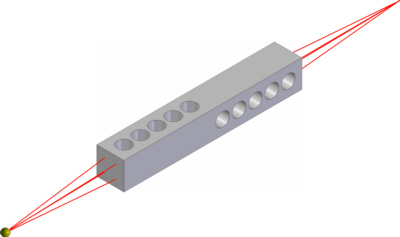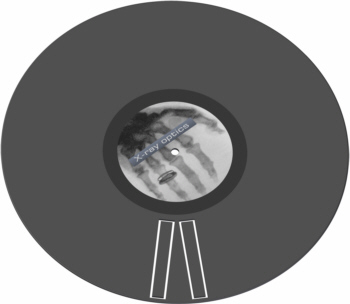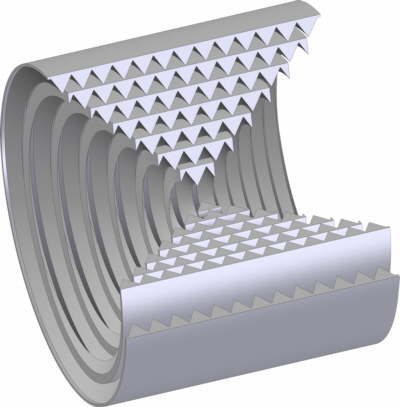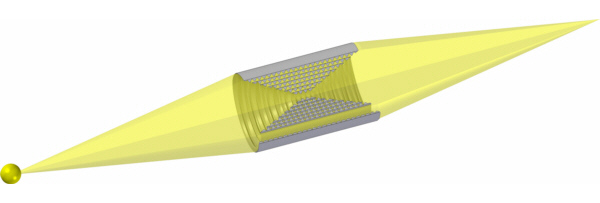First partly successful attempts to realize refractive X-ray lenses were started in the 1990th. Several approaches have been tested before some types turned out to be more promising than others. Some of these types are described here.
| Bubble lenses | Alligator lenses | Rolled X-ray prism lenses |
These lenses consisted of an aluminium or beryllium metal bar with a row of drilled holes in it (fig. 1), [Sni 1996]. As the refractive index of the air in the holes is higher than the refractive index of the aluminium, the holes in the bar act as cylindrical lenses. The whole arrangement forms a lens with a point focus, consisting of two perpendicular rows of cylinder lenses. There are two important disadvantages of these optics. First the large absorption because of the remaining material between two holes. The second disadvantage is the strong spherical aberration inherent to the production method.

Fig. 1: Refractive X-ray lens made of a row of holes in a metal bar
Bubble compound refractive lenses
Bubble compound refractive lenses (BCRL) consists of up to hundreds of gas bubbles in a capillary filled with epoxy resin [Dud 1998, Gar 2004]. The advantage of this optics is the ease of production. They suffer from the difficulty to control the geometry of the refracting surfaces formed by the meniscus of the resin when hardening, resulting in spherical aberration.

Fig. 2: Air bubbles arranged in a capillary form a refractive X-ray lens (only half shown for clarity)
Alligator lenses are also called multi prism lenses [Ced 2000, Ced 2002]. The first alligator lenses were made by cutting two stripes perpendicular to the grooves out of a long-playing vinyl record (fig. 3) and arranging them face-to-face and slightly inclined with respect to the optical axis (fig. 4). X-rays passing the plastic prisms formed by the grooves (record depending 25 µm to max. 90 µm deep, 180 µm pitch) are focussed to a line focus. This type of lenses has also been made of beryllium, silicon, epoxy and diamond using different fabrication methods.
The distance from the optical axis at which a beam passes through the maximum number of prisms can be adjusted via the tilt angle of the stripes. In this way the focal length can be chosen. When calculating the effect of this optics, it turns out that the prisms deflect the beam free of spherical aberration just like parabolic, compound refractive lenses do. As they are simple to produce, they might be useful in many applications.

Fig. 3: Long-playing vinyl record with two stripes cut out to make an alligator lens

Fig. 4: Alligator lens with line focus (here only one side of the LP shows grooves) 
A rolled X-ray prism lenses consist of a structured polymer foil that is rolled to form a spiral [Sim 2009; Kar 2009] (fig. 5).

Fig. 5: Sketch of a rolled X-ray prism lens (one quarter removed for clarity)
To make such a lens, a structured polymer foil is needed. This foil can e.g. be made by spincoating a silicon wafer that has been structured with parallel grooves with triangular profile [Sim 2009]. This can e.g. be done by anisotropically etching an Si-100 oriented wafer that has been masked with parallel lines of resin before. The resulting foil then consists of a thin supporting foil carrying ribs with triangular profile. The supporting foil has to be as thin as possible because it optically contributes only by absorption. The triangular ribs refracting the X-rays have to be as small as technically possible, because the smaller these prism ribs are, the larger is the ratio of the refracting surface to the absorbing volume of the prisms. To form the lens the foil is rolled by winding it around e.g. a core fibre (fig. 6 on mouse-over).
The incoming light is refracted at the surface of the prisms (fig. 6).

Fig. 6: Rolled X-ray prism lens with beam and sketch of the process of rolling the structured foil on mouse-over 
| [Ced 2000] | B. Cederström, R. Cahn, M. Danielsson, M. Lundqvist and D. Nygren, Focusing hard X-rays with old LP’s, Nature 404, p. 951, 2000 |
| [Ced 2002] | B. Cederström, A Multi-Prism Lens for Hard X-Rays, PhD thesis,Kungl Tekniska Högskolan, Stockholm, ISBN 91-7283-385-8, 2002 |
| [Dud 1998] | Yu. I. Dudchik and N. N. Kolchevsky, A microcapillary lens for X-rays, Nucl. Instrum. Methods Phys. Res., vol. A 421, p. 361, DOI: 10.1016/S0168-9002(98)01269-8, 1998 |
| [Gar 2004] | C. K. Gary, S. A. Pikuz, M. D. Mitchell, K. M. Chandler, T. A. Shelkovenko, D. A. Hammer, Yu. I. Dudchik, X-ray imaging of an X-pinch plasma with a bubble compound refractive lens, Rev. Sci. Instrum., vol. 75, p. 3950, DOI:10.1063/1.1789252, 2004 |
| [Sni 1996] | A. Snigirev, V. Kohn, I. Snigireva, B. Lengeler, A compound refractive lens for focusing high-energy X-rays, Nature, vol. 384, pp. 49-51, DOI: 10.1038/384049a0, 1996 |
| [Tom 1996] | T. Tomie, X-ray lens, Japanese Patent 1994000045288, priority 18.02.1994, 1996 |
| [Sim 2009] | M. Simon, Röntgenrolllinse, Patent DE102009031476A1, 01.07.2009 |
| [Kar 2009] | Approach and device for focusing x-rays, St. Karlsson, United States Patent Application 20090257563, filing date 11.4.2008, published 15.10.2009 |


